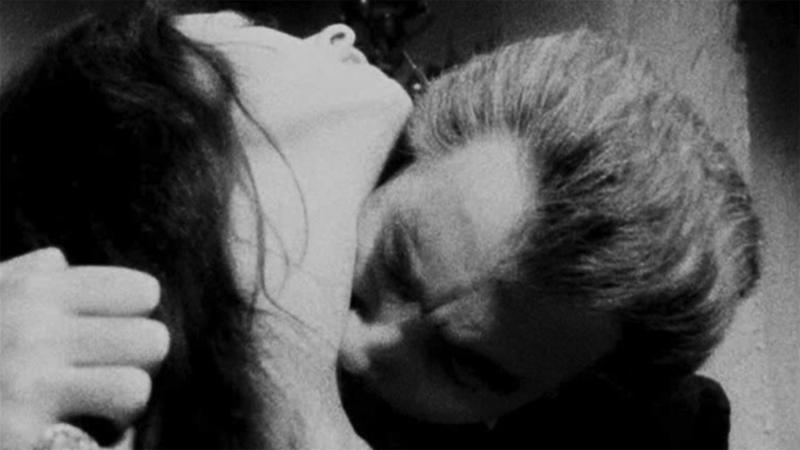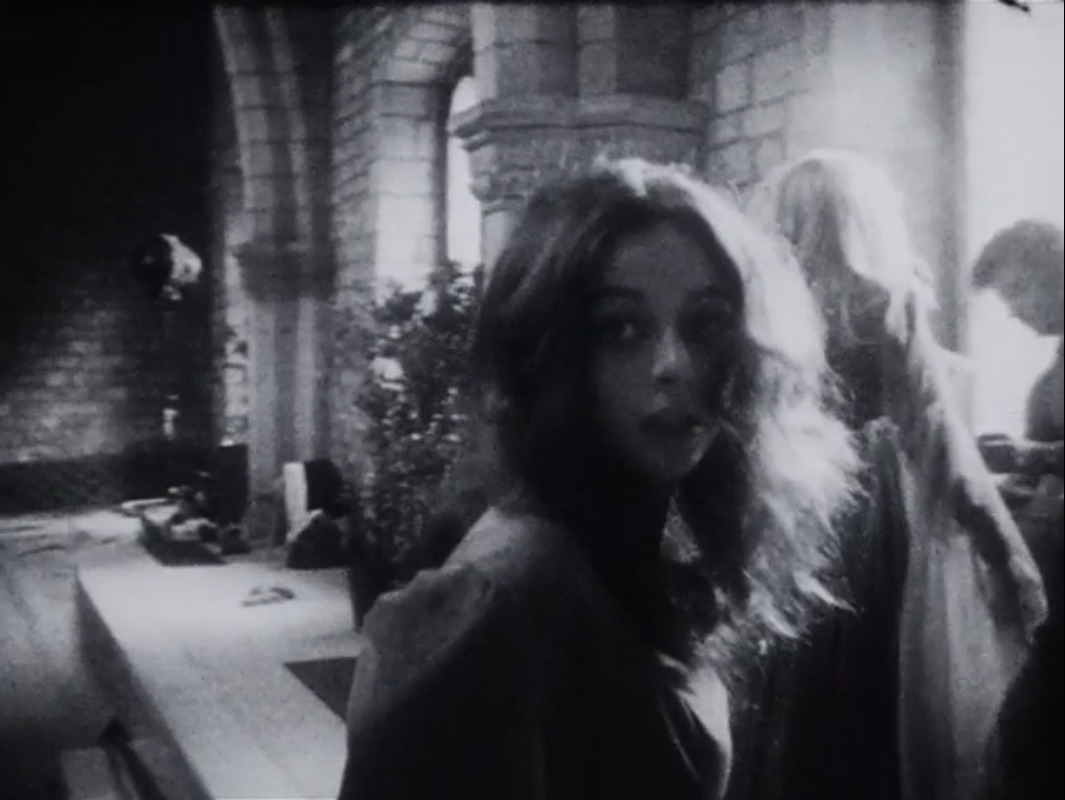DVD/Blu-ray: Vampir Cuadecuc | reviews, news & interviews
DVD/Blu-ray: Vampir Cuadecuc
DVD/Blu-ray: Vampir Cuadecuc
Experimental filmmaking with a bite: Christopher Lee in a 'Dracula' like none you've seen before

Pere Portabella’s remarkable Vampir Cuadecuc is almost impossible to classify. It may have been filmed on the set of Jesús Franco's 1970 Hammer horror film El Conde Dracula – with the obviously enthusiastic participation of a cast led by Christopher Lee – but it certainly isn’t a "making-of" film.
But it’s the Bram Stoker novel as we have never seen it before, focused through the intoxicating prism of cinema at its most experimental: images are in high-contrast black and white, often reversed, while the score by Carles Santos is a treat of contemporary music in itself, playing across a whole range of styles (louche lounge music is set against the scream of jet engines, and there are minutes towards the end when you may wonder if the soundtrack has stuck). It’s silent, except for the final few minutes (from a compact 65) in which Lee reads from the last scene of the novel to camera, another element that allies it to the Expressionist tradition of Murnau's Nosferatu or Dreyer's Vampyr.
It surely belongs as much in the art gallery as it does in the cinema
There’s an irony to the fact that Lee had apparently been drawn to Franco’s film for its promised faith to the original, particularly in following the novel’s structure. The designers of that film found some glorious locations around Catalonia, medieval basilicas and palaces that become even more atmospheric and charged in Portabella and cinematographer Manel Esteban’s visual riffing.
We can only guess at how on-set interaction between the two crews worked out: the process of Franco’s production is certainly a part of Portabella’s film, as we watch a smoke machine prepare for an exterior scene, or witness cameras, lighting and make-up in progress around the set (an awful lot of spiderwebs get sprayed on in the process). But it must have been amicable, and Franco and his British producer Harry Alan Towers can only be respected for engaging with the idea at all. Not least because Portabella, dating back to his producer role on Luis Bunuel’s 1961 Viridiana (which brought the director back to Spain) had a controversial reputation in the Spanish film establishment, and in the country as a whole. The confiscation of his passport meant that he couldn't attend the film’s 1971 Cannes screening, or another the next year at New York’s Museum of Modern Art (Vampir Cuadecuc surely belongs as much in the art gallery as it does in the cinema). The 29-minute interview with the director, specially filmed for this Second Run release, makes clear how the production was in every sense unofficial, equally unhindered by political pressures from the Franco regime as by union demands. The rough visual texture came from filming both with out-of-date Kodak stock, and on sound negative (in Catalan cuadecuc means “worm’s tail”, and also refers to the unexposed footage at the end of a roll of film).
The 29-minute interview with the director, specially filmed for this Second Run release, makes clear how the production was in every sense unofficial, equally unhindered by political pressures from the Franco regime as by union demands. The rough visual texture came from filming both with out-of-date Kodak stock, and on sound negative (in Catalan cuadecuc means “worm’s tail”, and also refers to the unexposed footage at the end of a roll of film).
Inevitably, it makes us ponder metaphoric comparisons with the wider political situation in Spain at the time, although it fits equally into local strands of Surrealism. Tantalising that there’s no sign of Klaus Kinski in Vampir Cuadecuc, given that the actor was in El Conde Dracula, and Portabella's mad visual style would surely have been right up his bonkers street. (Heavens only know how Herbert Lom ended up as Van Helsing.)
The cast clearly enjoyed their work on the side for Portabella, slipping him a wink or making faces, not least the only Spanish lead, Soledad Miranda (pictured above) playing Lucy Westenra. Lee must have appreciated Portabella's approach because he went straight on to another experimental film, Umbracle, with him. The political tone there was more overt, including a sequence of Spanish filmmakers discussing censorship: again Lee reads from a dark classic, this time Edgar Allan Poe's The Raven.
rating
Share this article
The future of Arts Journalism
You can stop theartsdesk.com closing!
We urgently need financing to survive. Our fundraising drive has thus far raised £49,000 but we need to reach £100,000 or we will be forced to close. Please contribute here: https://gofund.me/c3f6033d
And if you can forward this information to anyone who might assist, we’d be grateful.

Subscribe to theartsdesk.com
Thank you for continuing to read our work on theartsdesk.com. For unlimited access to every article in its entirety, including our archive of more than 15,000 pieces, we're asking for £5 per month or £40 per year. We feel it's a very good deal, and hope you do too.
To take a subscription now simply click here.
And if you're looking for that extra gift for a friend or family member, why not treat them to a theartsdesk.com gift subscription?
more Film
 London Film Festival - from paranoia in Brazil and Iran, to light relief in New York and Tuscany
'Jay Kelly' disappoints, 'It Was Just an Accident' doesn't
London Film Festival - from paranoia in Brazil and Iran, to light relief in New York and Tuscany
'Jay Kelly' disappoints, 'It Was Just an Accident' doesn't
 Iron Ladies review - working-class heroines of the Miners' Strike
Documentary salutes the staunch women who fought Thatcher's pit closures
Iron Ladies review - working-class heroines of the Miners' Strike
Documentary salutes the staunch women who fought Thatcher's pit closures
 Blu-ray: The Man in the White Suit
Ealing Studios' prescient black comedy, as sharp as ever
Blu-ray: The Man in the White Suit
Ealing Studios' prescient black comedy, as sharp as ever
 The Woman in Cabin 10 review - Scandi noir meets Agatha Christie on a superyacht
Reason goes overboard on a seagoing mystery thriller
The Woman in Cabin 10 review - Scandi noir meets Agatha Christie on a superyacht
Reason goes overboard on a seagoing mystery thriller
 London Film Festival 2025 - crime, punishment, pop stars and shrinks
Daniel Craig investigates, Jodie Foster speaks French and Colin Farrell has a gambling habit
London Film Festival 2025 - crime, punishment, pop stars and shrinks
Daniel Craig investigates, Jodie Foster speaks French and Colin Farrell has a gambling habit
 I Swear review - taking stock of Tourette's
A sharp and moving tale of cuss-words and tics
I Swear review - taking stock of Tourette's
A sharp and moving tale of cuss-words and tics
 A House of Dynamite review - the final countdown
Kathryn Bigelow's cautionary tale sets the nuclear clock ticking again
A House of Dynamite review - the final countdown
Kathryn Bigelow's cautionary tale sets the nuclear clock ticking again
 theartsdesk Q&A: Idris Elba on playing a US President faced with a missile crisis in 'A House of Dynamite'
The star talks about Presidential decision-making when millions of lives are imperilled
theartsdesk Q&A: Idris Elba on playing a US President faced with a missile crisis in 'A House of Dynamite'
The star talks about Presidential decision-making when millions of lives are imperilled
 Urchin review - superb homeless drama
Frank Dillane gives a star-making turn in Harris Dickinson’s impressive directorial debut
Urchin review - superb homeless drama
Frank Dillane gives a star-making turn in Harris Dickinson’s impressive directorial debut
 Mr Blake at Your Service review - John Malkovich in unlikely role as an English butler
Weird comedy directed by novelist Gilles Legardinier
Mr Blake at Your Service review - John Malkovich in unlikely role as an English butler
Weird comedy directed by novelist Gilles Legardinier
 Don't Let's Go to the Dogs Tonight review - vivid adaptation of a memoir about a Rhodesian childhood
Embeth Davidtz delivers an impressive directing debut and an exceptional child star
Don't Let's Go to the Dogs Tonight review - vivid adaptation of a memoir about a Rhodesian childhood
Embeth Davidtz delivers an impressive directing debut and an exceptional child star

Add comment